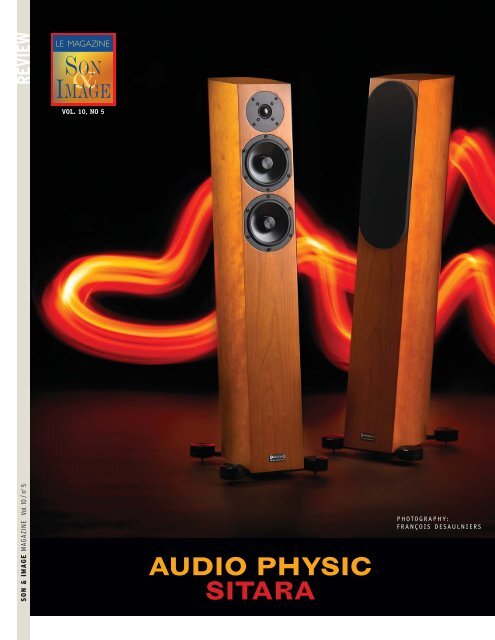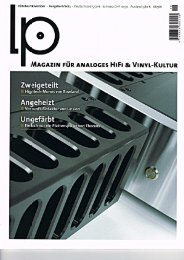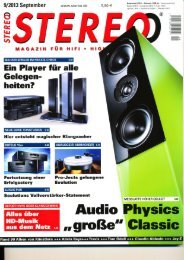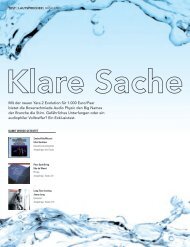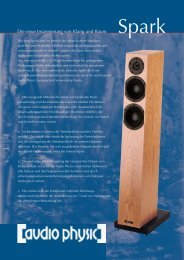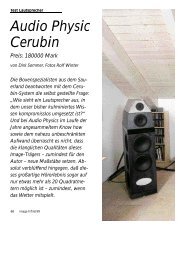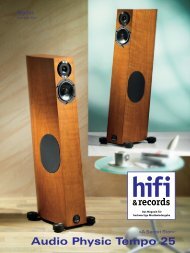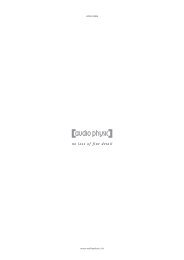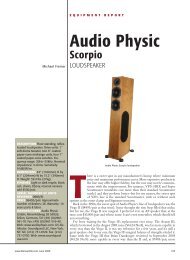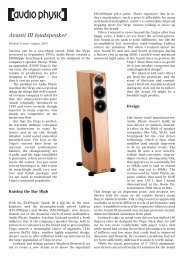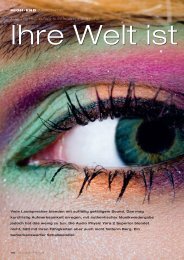review - Audio Physic
review - Audio Physic
review - Audio Physic
- TAGS
- audio
- physic
- audiophysic.de
Create successful ePaper yourself
Turn your PDF publications into a flip-book with our unique Google optimized e-Paper software.
REVIEW<br />
SON & IMAGE MAGAZINE Vol. 10 / n o 5<br />
LE MAGAZINE<br />
SON & IMAGE<br />
VOL. 10, NO 5<br />
AUDIO PHYSIC<br />
SITARA<br />
PHOTOGRAPHY:<br />
FRANÇOIS DESAULNIERS
It was 1973 when I first understood what a top-flight high-fidelity system could do. The speakers<br />
were the B&W DM70 hybrids: a 12" woofer in an imposingly wide cabinet, crowned by a curved ele-<br />
ven-element electrostatic panel. What I heard profoundly changed my perception of recorded music.<br />
Until then I had not believed it possible to so closely reproduce the emotion of a live concert. The<br />
epiphany was costly, as I’ve gone through many speakers in my quest to relive the experience:<br />
Hartley, Energy 22 Reference Connoisseur, Mordaunt and Short Pageant, Oracle Mentor Studio,<br />
Magnepan 1.6 QR, NHT 3.3, Totem Model 1, Enigma Oremus, Revelation Antares, Revelation Lyra 7,<br />
and Revelation Mistral S6. <strong>Audio</strong> <strong>Physic</strong> is sorely missing from the list, so you’ll understand my<br />
enthusiasm when our editor-in-chief proposed a pair of Sitara.<br />
AUDIO PHYSIC<br />
Founded nearly 25 years ago by a music lover<br />
searching to improve the sound of his ProAc<br />
Tablette speakers, <strong>Audio</strong> <strong>Physic</strong> has built a solid<br />
reputation based on the elegance of their speakers,<br />
the quality of the construction and of<br />
course their holographic imaging. The philosophy<br />
underlying the development of all their<br />
speakers (No loss of fine detail) has become their<br />
trademark, in all senses of the word.<br />
Located in the town of Brilon in Germany,<br />
<strong>Audio</strong> <strong>Physic</strong> ensures in-house the design, assembly,<br />
testing and quality control of their speakers. Cabinet<br />
construction is entrusted to the Danish firm Hornslet, developers<br />
of Hornflex, a patented technique for curving MDF<br />
panels, by means of multiple parallel grooves cut deeply<br />
into the wood. The curved panels reduce standing waves<br />
and the grooves also serve to increase box volume without<br />
altering the external dimensions.<br />
<strong>Audio</strong> <strong>Physic</strong> has revised their range of speakers into<br />
three series, Yara Line, High End and Reference, with a clear<br />
progression within and between each series. The Yara Line<br />
represents the entry level and, in order, consists of the<br />
Compact, Evolution, Classic and Superior models. The Sitara<br />
is the newest addition to the family and the entry point to<br />
the High End series, followed within that line by the Tempo<br />
and the Scorpio. The Reference line consists of the Virgo,<br />
the Avanti, the Caldera and the top-of-the line Kronos.<br />
At the Salon Son et Image this year in Montreal, <strong>Audio</strong><br />
<strong>Physic</strong> was well represented by the Canadian distributor<br />
Dimexs. Visitors could not only see and hear a wide sample<br />
of the <strong>Audio</strong> <strong>Physic</strong> range, but also chat with Dieter<br />
Kratochwil, CEO and Manfred Diestertich, in charge of<br />
research and development. I took the opportunity to interview<br />
them on their company and on the design objectives<br />
behind the Sitara. Under Manfred’s direction, the design of<br />
the entire range of speakers and their components has been<br />
revised and updated. Several novel approaches are used to<br />
achieve the <strong>Audio</strong> <strong>Physic</strong> signature sound, i.e., maximum<br />
information without falling into the trap of the hyper-analytical<br />
speaker. The key is obsessive attention to reducing<br />
vibration at its source and minimising its transmission<br />
between speaker components. For<br />
example, a U-shaped elastic ring is fit snugly<br />
around the rim of the cone in the mid-bass<br />
transducer, causing the diaphragm to tighten.<br />
This shifts resonances to beyond the range of<br />
human hearing and obviates the need to filter<br />
them out through the crossover. Designated by<br />
<strong>Audio</strong> <strong>Physic</strong> as the “Hyper Holographic Cone”<br />
(HHC), this technique is used in the High End<br />
and Reference series. The HHC transducer also<br />
employs another novel approach, the use of a<br />
double-basket construction to physically separate moving<br />
and fixed parts as much as possible. Moving parts, specifically<br />
the coil, suspension and diaphragm are aligned and<br />
held in place by an internal polymer basket designed for<br />
maximum vibration damping. The fixed part, the neodymium<br />
magnet, is attached to an external aluminium basket.<br />
This construction provides a mechanical barrier to the<br />
transmission of resonances from the cabinet or the basket<br />
to the diaphragm, and allows better transfer of heat from<br />
the coil. Lastly, to ensure another barrier to vibration, the<br />
transducers are mounted using neoprene grommets that<br />
prevent the basket from touching the cabinet. A warning to<br />
torque wrench fanatics: the nuts holding the speakers in<br />
place do not need tightening! Doing so will compromise the<br />
integrity of the supports and defeat their purpose.<br />
A GUIDED TOUR OF THE SITARA<br />
As explained to me by Manfred Diestertich, the design goals<br />
for the Sitaras were to achieve a speaker that is: adapted to<br />
small and medium sized rooms (15 to 25 m 2 ), capable of<br />
being correctly driven by “normal” equipment, for example<br />
a 40 to 50 watt amplifier, universally applicable and strong<br />
on imaging and emotion, entices the auditor to extend his<br />
listening sessions, and allows the listener to clearly follow<br />
the music from another room, (always a good sign of the<br />
intelligibility of the musical message!)<br />
A two-and-a-halfway configuration was selected to<br />
provide more energy in the bass frequencies. Frequency<br />
response is specified as 35 Hz to 40 kHz, with a nominal<br />
REVIEW<br />
SON & IMAGE MAGAZINE Vol. 10 / n o 5
SON & IMAGE MAGAZINE - REVIEW<br />
SON & IMAGE MAGAZINE Vol. 10 / n o 5<br />
impedance of 4 ohms<br />
and a sensitivity of<br />
89 dB. The Sitara is<br />
a physically attractive<br />
and well-proportioned<br />
speaker in the<br />
form of a 980 x 147 x<br />
220 mm column inclined<br />
seven degrees to<br />
the rear. The raked<br />
angle functions to improve<br />
sound dispersion<br />
into the room and phase<br />
alignment, and substantially<br />
contributes to the<br />
physical attractiveness of<br />
the speaker. The tweeter, a<br />
25 mm textile dome, and<br />
the 150 mm mid and bass<br />
transducers are set close<br />
together in the upper section<br />
of the column. I found<br />
the look appealing and felt<br />
no need to hide them behind<br />
the black cloth grills provided.<br />
Bass response is extended by a<br />
reflex vent located halfway<br />
down the rear face of the speaker.<br />
With the handily placed<br />
vent and their light weight of 17<br />
kg, the speakers are easy to<br />
reposition.<br />
The midrange and the bass<br />
transducers are both Hyper Holographic<br />
Cones, but differ slightly in<br />
their coil structure. The mid has a<br />
double-layer coil for less mass and<br />
better midrange reproduction, while<br />
the bass has a four-layer coil winding<br />
for more mass and inductance, and<br />
thus better control in the bass. Cutoff<br />
between the mid and bass is provided<br />
by a second-order filter with a corner<br />
frequency of 500 Hz, while a thirdorder<br />
filter does duties for the mids and<br />
the high-frequencies, with a corner frequency<br />
of 2,800 Hz. Again, to reduce<br />
the influence of vibration, the crossover<br />
is located in a sealed compartment<br />
at the base of the speaker,<br />
while the terminal plate is mounted<br />
on a neoprene support. The care<br />
taken to minimize vibration and control<br />
its dispersal is, to say the least, impressive.<br />
If the purchaser does not specify a preference,<br />
the speakers are delivered with<br />
single rhodium-plated WBT binding posts<br />
to avoid, according to Manfred, degradation<br />
of sound caused by jumper cables lin-<br />
king double binding posts. Double or triple<br />
binding posts are offered as an option.<br />
Support and stability of the speaker are assured<br />
by metal outrigger feet with machined<br />
adjustable spikes. Round covers (plastic but<br />
resembling metal) cover the outriggers and<br />
nicely complete the aesthetics. On a final<br />
technical note, the drivers are run in at the<br />
factory, so that the owner can quickly<br />
achieve the true sonic signature of the<br />
speakers. Nonetheless, <strong>Audio</strong> <strong>Physic</strong> recommends<br />
three days of run in to allow<br />
the speaker to reach its full expression.<br />
LEANING INTO THE MUSIC<br />
For preliminary listening during the<br />
three-day run-in period, I set up the<br />
speakers in a room measuring 4.6 x 3.4<br />
x 3 m at a distance of 0.6 m from the<br />
front wall, and 1.8 m apart. For the<br />
final touch, I levelled them with the<br />
round spirit level provided by <strong>Audio</strong><br />
<strong>Physic</strong>, a nice touch! You have to see<br />
and touch these speakers to truly<br />
appreciate the quality of the cabinetry.<br />
If the satin smooth finish of the<br />
speakers is any indication of their<br />
musical qualities, then we are in for<br />
a treat.<br />
First up: “Society” by Eddie<br />
Vedder from the soundtrack of<br />
Into the Wild, on system 1 (see<br />
Associated equipment). My first<br />
impression is of a total lack of<br />
exaggeration or attenuation anywhere<br />
in the frequency range.<br />
The song takes flight with Eddie<br />
Vedder’s voice warm and full of<br />
emotion, as it should be, and<br />
solidly positioned between the<br />
speakers. My wife stops her<br />
reading (which is rare) and<br />
sits with eyes closed, immersed<br />
in the song. She remarks<br />
that, for the first time, the<br />
metallic overtones on the<br />
guitar are audible. We continue<br />
with “Shape of My<br />
Heart” by Dominic Miller<br />
and Neil Stacey, where the<br />
interplay between the two<br />
guitarists is clear and precise,<br />
and a joy to follow.<br />
On the track “Ernest” by<br />
Jim Lampi, the bass<br />
notes of the Chapman<br />
stick are powerful and<br />
clearly delineated, pro-<br />
The 7° angled slim cabinet<br />
equalises phase differences<br />
viding the foundation<br />
between tweeter and midrange driver.
that is essential to this track.<br />
The first listening impressions are of a speaker<br />
that neatly steps aside providing a clear<br />
channel for the musician’s technique and the<br />
emotional message. The Sitaras are capable of<br />
extracting a wealth of sonic detail and are able<br />
to clearly separate musical threads, but it’s<br />
never at the expense of the music. The only<br />
drawback I could detect was the slightly smaller<br />
scale on which instruments and musicians<br />
are presented, but this did not detract from<br />
the overall experience. During the three days<br />
of run-in I noted little change in the speakers’<br />
character, other that a slight opening<br />
up of the soundstage.<br />
Time to get serious. I hooked up the Sitaras<br />
to system 2 (see Associated equipment).<br />
The listening room (6.7 m x 7.6 m with a<br />
cathedral ceiling of 4.3 m) is larger than the<br />
15 to 25 square metres recommended by<br />
<strong>Audio</strong> <strong>Physic</strong>. In this case the manufacturer<br />
suggests adding one or two subwoofers, but<br />
I didn’t find it necessary, as the bass was<br />
just fine the speakers alone. During a sevenhour<br />
session, I played with various positioning<br />
and ended up listening in a close-field<br />
configuration, with the speakers 1.8m<br />
away and separated by 2m. In this set-up,<br />
it was like wearing giant headphones.<br />
Imaging was surreal: pinpoint, deep, high<br />
and wide. I could honestly forgot a surround<br />
sound system. The proof? Several<br />
minutes into the track “Moussa” by the<br />
Hadouk Trio, someone in the audience<br />
coughs and I could pinpoint it at 2<br />
meters outside the left speaker, 1 metre<br />
behind and 30 cm above. I backed up<br />
the CD player three times just to be sure<br />
that it was in the recording...<br />
Again with the track “Society” by<br />
Eddie Vedder, every inflection of his<br />
voice is clear and the movement of his<br />
fingers on the guitar are virtually<br />
visible. Here again, it’s not the sound<br />
that draws my attention but the<br />
music. From the opening notes, time<br />
is suspended and I am captured and<br />
carried along in a journey that is difficult<br />
to resist. In fact it is impossible<br />
to do anything else while the music<br />
is playing. For a change of pace, and<br />
to test the resolution capacities of<br />
the Sitaras, what else but Amon<br />
Tobin? In the track “Marine<br />
Machines” from the<br />
Supermodified album, there<br />
is absolutely no congestion<br />
despite the incredible<br />
density of this multitrac-<br />
ked work. Remarkable, and a<br />
difficult test for a speaker. My<br />
early aural education involved<br />
many large speakers where the<br />
bass was ample and deep,<br />
which perhaps explains my dissatisfaction<br />
with most modern<br />
smaller speakers. In this regard,<br />
the Sitara performed admirably:<br />
in Kruder and Dorfmeister’s<br />
track Bomb The Bass, from the<br />
Bug Powder Dust (Dub remix<br />
album) the <strong>Audio</strong> <strong>Physic</strong> Sitara<br />
delivered all of the depth and<br />
power of the bass, reaching<br />
solidly down to the subterranean<br />
levels that this track requires. I<br />
could not detect any cabinet<br />
resonances during my listening<br />
sessions, a testament to the effort<br />
that has gone into the control of<br />
vibrations in this speaker.<br />
Throughout the sound spectrum,<br />
my impressions were that<br />
the speakers correctly deliver the<br />
harmonic envelope of each instrument<br />
and sound, even if the sound<br />
is synthesized. I was surprised to<br />
discover a realm of new sounds and<br />
effects in the Kruder and Dorfmeister<br />
album, and relieved to find<br />
that no mental effort was required<br />
to decode the envelope – the brain<br />
just accepting each one for what it<br />
is and revelling in the sense or emotion<br />
conveyed. This speaks highly of<br />
the integration between the different<br />
drivers, in the frequency and<br />
phase domains. Soundstaging was<br />
three dimensional, solid and stable,<br />
presenting the spatial effects in<br />
Kruder & Dorfmeister’s music with a<br />
remarkable degree of precision.<br />
We’ll stay with German music, but<br />
from a different era, this time the<br />
Sinfonia for strings and continuo by<br />
Fasch, recorded in the Carl Schroeder<br />
concert hall in Sonderhausen. The performance<br />
is luminous and airy and I am<br />
immediately transported to the concert<br />
hall. The violins come through beautifully<br />
with a degree of resolution and<br />
purity uncommon for a<br />
reproduction of this instrument.<br />
On to France with the<br />
Sonatas de violoncelle by<br />
Jean-Baptiste Barrière, and<br />
the first movement of the<br />
“Sonata 1 en si mineur. The<br />
REVIEW<br />
SON & IMAGE MAGAZINE Vol. 10 / n o 5
SON & IMAGE MAGAZINE - REVIEW<br />
SON & IMAGE MAGAZINE Vol. 10 / n o 5<br />
ASSOCIATED EQUIPMENT<br />
SYSTEM 1<br />
• Source: Naim CDX<br />
• Amplifier: <strong>Audio</strong>lab 8000S integrated<br />
• Interconnect: Chord Cobra<br />
• Speaker cable: Naim NAC A5<br />
• Speakers: Revelation <strong>Audio</strong> Antares<br />
SYSTEM 2<br />
• Source: Naim CDS2<br />
• Preamplifier: Naim NAC 82 & HiCap<br />
• Amplifier: Naim NAP 250<br />
• Interconnect: Naim HiLine<br />
• Speaker cable: Naim NAC A5<br />
• Speakers: Revelation <strong>Audio</strong> Mistral S6,<br />
Mordaunt& Short Pageant series 2<br />
• Accessories: dedicated electrical circuit<br />
(10-guage wire) and Hubbell plugs<br />
pace of this movement is deliberately slow and when the cellist<br />
pauses between phrases, the silence is so palpable that I<br />
hold my breath until the playing begins again. Again, it’s not<br />
the sound that grabs my attention, but rather the clear<br />
impression of finding myself in an intimate concert hall.<br />
If you are looking for speakers<br />
that combine holographic<br />
imaging, excellent tonal<br />
balance, dynamics, emotion,<br />
all presented in top-notch<br />
cabinetwork, then have a<br />
good look and listen to the<br />
Sitara.<br />
My preferred track for ending a listening session is<br />
“Cyrano” by the reclusive artist Edgar Bori. When correctly<br />
reproduced, the emotional depth of this track is so powerful<br />
and fulfilling that I find it impossible to listen to anything<br />
else afterwards. On the Sitara, the piano notes that open the<br />
track immediately set the tone of disconnection. The effect is<br />
striking and I realize for the first time why: the piano has<br />
been recorded out of phase. The technique sets the backdrop<br />
perfectly – a feeling of detachment and loss – on which Bori<br />
artfully paints with his voice and his poetry. The contrast between<br />
the warmth of his voice and the strangely distant piano<br />
creates the tension which is crucial to Bori’s text. You can<br />
guess the conclusion: it was useless to try to follow with any<br />
other music after this track. I just wanted to sit for a few<br />
minutes absorbing the space and the silence left after the<br />
track ends. Absolutely sublime!<br />
DISCOGRAPHY<br />
• Amon Tobin. Supermodified. Ninja Tune. zen CD48<br />
• Eddie Vedder. Film Soundtrack.<br />
Into the Wild. Sont BMG 88697-15944-2<br />
• Dominic Miller & Neil Stacey. New Dawn.<br />
Spinning Dog Records CD066<br />
• Edgar Bori. Bori<br />
• JF Fasch. Sinfonia FWV M:A2 pour cordes et basse<br />
continue. Les Amis de Philippe, CPO 7774242<br />
• Jean Barrière. Sonates pour violoncelle avec basse<br />
continue. Bruno Cocset. Les Basses Réunies.<br />
• Jim Lampi. Greazy. Spinning Dog Records CR01<br />
• Hadouk Trio. Live à FIP - Hadouk Trio (2CD)<br />
Celluloïd/Melodie 67053<br />
• Kruder & Dorfmeister. The K&D Sessions.<br />
G-Stone Recordings. !K7 Records. !K7073CD<br />
VERDICT<br />
Competence, assurance and ease are the three words that<br />
kept coming back to me during the time I spent listening<br />
casually or intently to music through the Sitaras. With<br />
these speakers I always felt confident that any track I<br />
chose would be a musical experience unmarred by exaggeration<br />
or distortion anywhere in the frequency band. I started<br />
the listening session convinced that sooner or later the<br />
5.9 inch drivers would call attention to themselves by a<br />
resonance in the highs, but I gave up my search, because<br />
in addition to the leitmotif of “No loss of fine detail” it<br />
should be added “No addition of artificial detail.” If you are<br />
looking for speakers that combine holographic imaging,<br />
excellent tonal balance, dynamics, emotion, all presented<br />
in top-notch cabinetwork, then have a good look and listen<br />
to the Sitara.<br />
I’ll leave the last words to my musician son who tested<br />
the Sitaras while I was away at my day job: “From the driving<br />
percussions of Novalima, to Robbie Shakespeare’s deep<br />
bass lines, to the distortion-drenched guitar of Trent Reznor,<br />
the Sitaras redefined my view of high fidelity. These are enormously<br />
versatile speakers that adapt perfectly to each style<br />
of music and instrument, without favouring one aspect to<br />
the detriment of another; speakers that are open to all the<br />
musical cultures of the world.”<br />
BY JAN-ERIK NORDOEN<br />
LE MAGAZINE<br />
SON<br />
IMAGE &<br />
Son & Image Magazine is available in paper<br />
and electronic formats.<br />
Details on www.son-et-image.com<br />
<strong>Audio</strong> <strong>Physic</strong> Sitara<br />
Price: $4,500 CND (cherry finish)<br />
www.audiophysic.de<br />
Canadian distributor: Dimexs<br />
514-333-5444 – www.dimexs.com
BANC D’ESSAI<br />
MAGAZINE SON & IMAGE Vol. 10 / n o 5<br />
LE MAGAZINE<br />
SON & IMAGE<br />
VOL. 10, N O 5<br />
AUDIO PHYSIC<br />
SITARA<br />
PHOTOGRAPHIE:<br />
FRANÇOIS DESAULNIERS
L’aventure de la haute fidélité a commencé pour moi en 1973 lorsqu’un de mes professeurs à l’école secondaire<br />
m’invita avec un groupe de copains pour une session d’écoute chez lui. L’identité de la source et des<br />
électroniques ne m’est pas restée, mais celle des enceintes oui! C’était des B&W DM70 hybride: un transducteur<br />
de basse fréquence de 13 pouces dans un caisson énorme, surmonté d’un panneau courbé composé de<br />
onze éléments électrostatiques. Cette écoute m’a profondément bouleversé. Je ne croyais pas que c’était possible<br />
de se rapprocher autant d’un concert en direct. J’étais figé devant ces énormes boîtes et plongé dans<br />
une monde sonore dont j’ignorais l’existence. Voici quelques-unes des enceintes qui m’ont depuis accompagné<br />
dans la quête de l’expérience originale: Hartley, Energy 22 Reference Connoisseur, Oracle Mentor Studio,<br />
Magnepan 1.6 QR, NHT 3.3, Totem Model 1, Enigma Oremus, Révélation Antares, Révélation Lyra 7, et<br />
Révélation Mistral S6. Vous comprendrez mon ravissement lorsque notre rédacteur en chef m’a proposé une<br />
paire de <strong>Audio</strong> <strong>Physic</strong> Sitara. JAN-ERIK NORDOEN<br />
AUDIO PHYSIC<br />
Fondé il y près de 25 ans par un mélomane qui<br />
cherchait à améliorer le son de ses ProAc<br />
Tablette, <strong>Audio</strong> <strong>Physic</strong> a depuis bâti une solide<br />
réputation basée sur l’élégance de ses enceintes,<br />
le soin apporté à leur construction et surtout<br />
l’holographie sonore qu’elles procurent. La philosophie<br />
qui soutient le développement de toutes<br />
leurs enceintes “No loss of fine detail” (aucune<br />
perte d’information fine) est devenue leur<br />
marque de commerce.<br />
Située dans la ville de Brilon en Allemagne, la<br />
firme <strong>Audio</strong> <strong>Physic</strong> assure la conception, l’assemblage<br />
et le contrôle de qualité de ses enceintes. La<br />
fabrication des cabinets est confiée à la société<br />
danoise Hornslet, développeur de la technologie<br />
Hornflex. Il s’agit d’une technique brevetée qui<br />
permet de courber des panneaux de MDF à l’aide de<br />
multiples rainures parallèles coupées en profondeur<br />
dans le bois. La technique procure deux avantages.<br />
D’abord la réduction d’ondes stationnaires en raison de l’absence<br />
de surfaces parallèles, puis l’augmentation du volume<br />
interne grâce aux multiples rainures.<br />
La gamme d’enceintes d’<strong>Audio</strong> <strong>Physic</strong> se décline en trois<br />
séries avec une progression claire entre elles et ce, dans<br />
chaque série: Yara Line, High End et Reference. La série Yara<br />
Line constitue le niveau d’entrée et comprend, dans l’ordre,<br />
des modèles: Compact, Evolution, Classic et Superior. La<br />
Sitara est le nouveau-né et se situe au début de la série<br />
High End, qui se poursuit avec les modèles Tempo et<br />
Scorpio, tandis que la série Reference est composée, dans<br />
l’ordre, des Virgo, Avanti, Caldera et Kronos.<br />
Au Salon Son et Image cette année, on pouvait non seulement<br />
voir et entendre plusieurs modèles d’enceintes<br />
d’<strong>Audio</strong> <strong>Physic</strong> au salon Dimex, mais aussi rencontrer Dieter<br />
Kratochwil, PDG et Manfred Diestertich, responsable de la<br />
recherche et du développement. J’ai profité de leur présence<br />
pour les questionner sur <strong>Audio</strong> <strong>Physic</strong> et sur les raisons<br />
d’être de l’enceinte Sitara. Sous la direction de Manfred, la<br />
conception de l’ensemble des enceintes d’<strong>Audio</strong> <strong>Physic</strong> et<br />
leurs composantes a été revue et corrigée. Plusieurs approches<br />
novatrices sont employées dans le but d’atteindre le<br />
signature sonore propre à <strong>Audio</strong> <strong>Physic</strong>, soit le maximum<br />
d’information sans tomber dans le piège de l’enceinte<br />
hyper-analytique. D’autres fabricants l’ont bien compris; je<br />
pense à Naim et le soin maniaque apporté à<br />
minimiser et contrôler les vibrations et les résonances<br />
pouvant brouiller le signal électronique<br />
et donc le message musical. Chez <strong>Audio</strong> <strong>Physic</strong>,<br />
on retrouve cette même obsession qui vise à<br />
amortir les vibrations à la source et minimiser<br />
leur transmission entre les composantes des<br />
enceintes. Par exemple, le pourtour du diaphragme<br />
d’aluminium du transducteur de fréquences<br />
moyennes et graves est muni d’un anneau élastique,<br />
dont la section est en «U», afin de maintenir<br />
le diaphragme sous tension et ainsi déplacer<br />
sa fréquence de résonance au-delà de la limite<br />
de l’audition. Cette technologie, baptisée<br />
«Hyper Holographic Cone», vise à éliminer les<br />
résonances désagréables souvent perceptibles<br />
avec les cônes rigides et elle est déployée dans les<br />
transducteurs de la série High End et Reference.<br />
Ce transducteur bénéficie également d’une autre<br />
technologie novatrice, soit l’emploi d’un double saladier.<br />
Les composantes vibrantes, soit le diaphragme, la suspension<br />
et la bobine, sont alignées et maintenues en place par<br />
un saladier interne en polymère conçu pour assurer un<br />
maximum d’atténuation de vibrations. L’aimant en néodyme<br />
est fixé dans un saladier externe d’aluminium. Cette<br />
construction fournit une barrière mécanique à la transmission<br />
de résonances du cabinet et du saladier vers le diaphragme<br />
et permet une meilleure évacuation de la chaleur<br />
produite par la bobine. Finalement, pour assurer une autre<br />
barrière à la transmission de vibrations, les transducteurs<br />
sont installés sur des supports en néoprène. Avertissement<br />
aux amateurs de clés dynamométriques. Inutile de resserrer<br />
les écrous après quelques mois d’écoute, car ce geste compromettra<br />
l’intégrité de ces supports.<br />
VISITE GUIDÉE DE LA SITARA<br />
Selon Manfred Diestertich, l’objectif avec les Sitara était de<br />
produire une enceinte adaptée aux petites et moyennes<br />
pièces, soit de 15 à 25 mètres carrés, pouvant être alimentée<br />
adéquatement par un équipement «normal», par exemple<br />
un amplificateur de 40 à 50 watts. On voulait faire une<br />
enceinte d’une «application universelle» qui fournit l’image<br />
et l’émotion si chère aux concepteurs chez <strong>Audio</strong> <strong>Physic</strong> et<br />
qui donnerait envie d’écouter davantage de musique. Autre<br />
objectif de l’enceinte, celui de permettre à l’auditeur de<br />
BANC D’ESSAI<br />
MAGAZINE SON & IMAGE Vol. 10 / n o 5
BANC D’ESSAI<br />
MAGAZINE SON & IMAGE Vol. 10 / n o 5<br />
suivre la musique<br />
d’une autre pièce<br />
sans difficulté, ce qui<br />
est toujours un bon<br />
indice de l’intelligibilité<br />
du message musical.<br />
La formule deux<br />
voies et demie a été<br />
retenue afin de fournir<br />
plus d’énergie dans les<br />
basses fréquences. La<br />
réponse en fréquence est<br />
spécifiée de 35 Hz à 40<br />
kHz, avec une impédance<br />
nominale de 4 ohms et<br />
une sensibilité de 89 dB.<br />
L’enceinte se présente sous<br />
la forme d’une élégante<br />
colonne aux dimensions 980<br />
x 147 x 220 mm. Pour un<br />
meilleure alignement des<br />
phases, elle est inclinée de<br />
sept degrés vers l’arrière.<br />
L’angle donne un motif distinctif<br />
et ajoute énormément à<br />
l’attrait physique de l’enceinte.<br />
Le tweeter de 25 mm en textile<br />
et les transducteurs des<br />
moyennes et des graves de 150<br />
mm sont logés dans la partie<br />
supérieure de la façade, formant<br />
un ensemble visuellement agréable.<br />
Je n’ai pas senti le besoin de<br />
cacher les transducteurs derrière<br />
les grilles fournies avec les enceintes.<br />
Un évent situé à l’arrière<br />
de l’enceinte permet de développer<br />
davantage la réponse dans les<br />
basses. De plus, selon Manfred,<br />
l’évent offre une excellente prise<br />
lorsqu’on déplace l’enceinte.<br />
On retrouve deux transducteurs<br />
«Hyper Holographic Cone» pour les<br />
moyennes et les basses fréquences, mais<br />
avec des bobines modifiées. Le transducteur<br />
des moyennes fréquences comporte<br />
une bobine constituée de deux séries<br />
d’enroulements pour une masse moindre<br />
et une meilleure reproduction<br />
dans cette gamme de fréquences. La<br />
coupure entre les moyennes et les<br />
basses est établie à 500 Hz avec un filtre du<br />
deuxième ordre. Le transducteur des basses<br />
utilise une bobine de quatre séries d’enroulements<br />
pour plus de masse et d’inductance<br />
contribuant à de meilleures basses. Entre les<br />
moyennes et hautes fréquences, la coupure<br />
se situe à 2 800 Hz avec un filtre du troisiè-<br />
me ordre. Toujours dans le but de minimiser l’influence<br />
des vibrations, le filtre électronique de<br />
séparation des fréquences est localisé dans un<br />
compartiment scellé à la base de l’enceinte, et<br />
la plaque des borniers est montée sur un support<br />
en néoprène. Le soin apporté au contrôle<br />
des vibrations est pour le moins impressionnant.<br />
Si on ne le précise pas à l’achat, les<br />
enceintes sont livrées avec des borniers<br />
simples WBT, plaquées en rhodium. Ce choix<br />
est pour éviter, selon Manfred, la dégradation<br />
du son causée par les liaisons «jumper»<br />
reliant des borniers doubles. Si l’acheteur<br />
le désire, des borniers doubles ou<br />
triples sont offerts en option. Le support<br />
et la stabilité de l’enceinte sont assurés<br />
par des pieds en métal accompagnés de<br />
pointes ajustables. Des couvercles ronds<br />
viennent cacher les piétements favorisant<br />
l’allure de l’ensemble. Dernier élément<br />
technique: les transducteurs sont<br />
rodés à l’usine, afin que le propriétaire<br />
puisse bénéficier le plus rapidement<br />
possible du son tel qu’il a été conçu<br />
par le fabricant. Néanmoins, <strong>Audio</strong><br />
<strong>Physic</strong> suggère trois jours de rodage<br />
permettant à l’enceinte d’atteindre<br />
son expression complète.<br />
VOIE LIBRE À LA MUSIQUE<br />
Pour les trois jours de rodage et<br />
d’écoute préliminaire, j’ai installé<br />
les enceintes dans un petit salon<br />
de 4,6 x 3.4 x 3 m à 0,6 m des<br />
murs latéraux et à 0,5 m du mur<br />
arrière, et distancées de 1,8<br />
mètre. Pour la touche finale, j’ai<br />
mis les enceintes à niveau à l’aide<br />
du niveau à bulle griffé <strong>Audio</strong><br />
<strong>Physic</strong> fourni avec les Sitara.<br />
Chouette! Il faut voir et surtout<br />
toucher ces enceintes pour<br />
apprécier la grande qualité de<br />
l’ébénisterie; aucune aspérité<br />
ne vient troubler les surfaces<br />
soyeuses. Si la musique est à<br />
la hauteur de la finition,<br />
voilà qui augure bien!<br />
On débute sur le système<br />
1 (voir l’encadré) avec la<br />
pièce «Society» d’Eddie<br />
Vedder de la trame sonore<br />
du film Into the Wild.<br />
Première impression: rien,<br />
mais absolument rien qui<br />
dérange ou qui agresse.<br />
On ne ressent aucune<br />
exagération ou atténua-<br />
L’angle de 7 degrés du<br />
cabinet harmonise les différences<br />
tion d’aucune partie du<br />
de phase entre les transducteurs de haute<br />
et de moyenne fréquence
spectre sonore. La chanson coule avec la voix<br />
d’Eddie Vedder chaude à souhait. Ma conjointe<br />
arrête sa lecture pour venir écouter (ce qui est<br />
rare) et demeure les yeux fermés, immergée dans<br />
la chanson. Elle remarque qu’on entend pour la<br />
première fois le côté métallique des cordes de guitare.<br />
On poursuit avec Shape of My Heart de<br />
Dominic Miller et Neil Stacey, ou l’interaction des<br />
deux guitaristes est nette et claire, très facile à<br />
suivre. Sur le morceau «Ernest» de Jim Lampi, la<br />
sonorité des basses du Chapman Stick est ample<br />
et clairement présentée fournissant la fondation<br />
essentielle à cette pièce de musique. La première<br />
impression d’écoute révèle des enceintes qui<br />
s’effacent laissant la voie libre pour comprendre<br />
la technique de l’interprète, l’émotion<br />
véhiculée, l’emphase mise sur certaines notes,<br />
en fait, des détails musicaux et non des détails<br />
sonores. Les instruments et les musiciens sont<br />
présentés avec des proportions légèrement<br />
réduites, mais on s’habitue rapidement.<br />
Durant les trois jours de rodage, je n’ai décelé<br />
aucun changement majeur, ne serait-ce<br />
qu’une légère ouverture de l’image sonore<br />
des Sitara.<br />
Passons maintenant aux choses sérieuses,<br />
soit l’écoute prolongée sur le système 2 (voir<br />
l’encadré). Cette fois la pièce mesure 6,7 m<br />
x 7,6 m avec un plafond cathédrale de 4,3<br />
m. C’est plus que les 15 à 25 mètres carrés<br />
prévus par le fabricant, et dans ce cas,<br />
<strong>Audio</strong> <strong>Physic</strong> recommande l’ajout d’un ou<br />
deux caissons de grave, ce que je n’ai pas<br />
fait étant amplement satisfait des basses.<br />
Au cours de l’écoute, j’ai expérimenté plusieurs<br />
géométries pour finir dans une<br />
écoute en champs proche, soit à 1,8 m et<br />
les enceintes distancées de 2 m. Dans<br />
cette configuration, c’était comme si je<br />
portais des écouteurs énormes. L’image<br />
sonore est à ce point profonde, haute et<br />
large, qu’il me serait possible de me passer<br />
d’un système 5.1. La preuve…<br />
Quelques minutes après le début de la<br />
pièce «Moussa» du Hadouk Trio, un<br />
membre de l’auditoire tousse et c’est<br />
exactement à deux mètres à l’extérieur<br />
de l’enceinte gauche, un mètre derrière<br />
et 30 cm au dessus. J’ai reculé le<br />
lecteur trois fois pour m’assurer que<br />
c’était bel et bien dans l’enregistrement…<br />
De nouveau avec la pièce<br />
«Society» d’Eddie Vedder,<br />
la voix est pleine d’émotion<br />
et on sent très bien le<br />
mouvement des doigts sur<br />
les cordes. Mais ce n’est<br />
pas le son qui m’interpelle,<br />
c’est le message musical. Dès<br />
les premières notes, on embarque<br />
dans la chanson; la<br />
musique coule et le temps est<br />
suspendu. Il est difficile de faire<br />
autre chose pendant que la<br />
musique joue. Changement de<br />
registre vers la musique électronique<br />
et question de tester la<br />
capacité de résolution de l’enceinte,<br />
Amon Tobin est de rigueur.<br />
Dans la pièce «Marine<br />
Machines» du disque Supermodified,<br />
je ne ressens aucune<br />
congestion à travers la densité<br />
des sons. Remarquable, c’est un<br />
test difficile pour une enceinte.<br />
Du côté des basses, on poursuit<br />
avec Kruder et Dorfmeister Bomb<br />
The Bass – «Bug Powder Dust»<br />
(Dub remix). Les enceintes n’ont<br />
pas hésité à livrer toute la puissance<br />
des basses profondes de ce morceau;<br />
les Sitara sont assurées et<br />
solides. Je n’ai pas décelé de résonances<br />
audibles du cabinet durant<br />
l’écoute, ce qui témoigne de la qualité<br />
de maîtrise des vibrations. Sur<br />
l’ensemble du spectre sonore, on<br />
sent que l’enveloppe harmonique de<br />
chaque instrument ou de chaque son<br />
électronique est correcte; le cerveau<br />
ne cherche pas à l’identifier, tout<br />
étant clair immédiatement. Je me<br />
suis même surpris à découvrir des<br />
sons électroniques sur ce disque que<br />
je ne connaissais pas, et à leur écoute,<br />
je ne cherchais pas à les identifier,<br />
mais plutôt de les apprécier et me<br />
laisser inspirer par le sens qu’ils véhiculent.<br />
Du côté de l’image sonore,<br />
c’était tridimensionnel, solide et<br />
stable. Les effets sonores dans la<br />
musique de Kruder et Dorfmeister ressortent<br />
avec une précision remarquable.<br />
Restons dans la musique allemande,<br />
mais d’une autre époque, cette fois la<br />
Sinfonia pour cordes et continuo de<br />
Fasch, enregistré à la salle de concert<br />
Carol Schroeder à Sonderhausen. La<br />
prestation est lumineuse, claire<br />
et aérée; on est transporté<br />
dans la salle. Les violons<br />
passent très bien avec un<br />
niveau de finesse qui n’est<br />
pas commun pour la reproduction<br />
de cet instrument.<br />
Nous voilà ensuite en France<br />
BANC D’ESSAI<br />
MAGAZINE SON & IMAGE Vol. 10 / n o 5
BANC D’ESSAI<br />
MAGAZINE SON & IMAGE Vol. 10 / n o 5<br />
ÉQUIPEMENT ASSOCIÉ<br />
SYSTÈME 1<br />
• Lecteur Naim CDX<br />
• Ampli intégré <strong>Audio</strong>lab 8000S (60 watts)<br />
• Câble d’interconnexion Chord Cobra<br />
et d’enceintes Naim NAC A5.<br />
SYSTÈME 2<br />
• Circuit électrique dédié avec fil de calibre 10<br />
et prises AC Hubbell<br />
• Lecteur Naim CDS2<br />
• Préampli NAC82 & HiCap<br />
• Ampli NAP 250 (80 watts)<br />
• Câbles d’enceintes Naim NACA5<br />
et d’interconnexion HiLine<br />
avec les Sonates de violoncelle de Jean Barrière, et le premier<br />
mouvement de la «Sonate 1 en si mineur». Ce mouvement<br />
est très lent et lorsque le violoncelle arrête entre les<br />
phrasés, on retient son souffle tellement le silence est plein<br />
de suspense. Ce ne sont pas les détails sonores qui m’importent,<br />
mais davantage l’impression de me retrouver dans une<br />
salle de concert.<br />
Si vous recherchez des enceintes<br />
capables d’allier imagerie<br />
holographique, équilibre tonal,<br />
dynamique, émotion, le tout joint<br />
à une ébénisterie hors pair,<br />
aller jeter un coup d’œil<br />
et un coup d’oreille aux<br />
Sitara de <strong>Audio</strong> <strong>Physic</strong><br />
J’ai une pièce préférée pour terminer des séances d’écoute,<br />
«Cyrano» d’Edgar Bori. Lorsque cette pièce passe bien sur<br />
un système, l’émotion est tellement forte que je me retrouve<br />
dans l’impossibilité d’écouter autre chose après. Au contact<br />
des Sitara, dès les premières notes du piano qui ouvrent ce<br />
morceau, on se sent toute de suite déconnecté. L’effet est<br />
saisissant et je m’aperçois, pour la première fois que c’est en<br />
fait le piano qui a été enregistré en phase inversée. Cette<br />
technique établit à merveille la trame de fond – le sentiment<br />
de détachement et de perte – sur laquelle Bori vient poser sa<br />
voix chaleureuse et sa poésie. Le contraste entre la chaleur<br />
de la voix et le piano étrangement distant établit la tension<br />
qui est si importante au texte de Bori. Vous l’aurez compris,<br />
c’était inutile d’essayer d’enchaîner après cette pièce. On<br />
veut simplement rester quelques instants dans le silence,<br />
dans l’espace qui a été créé. Sublime!<br />
DISCOGRAPHIE<br />
• Amon Tobin. Supermodified. Ninja Tune. zen CD48<br />
• Eddie Vedder. Bande originale du film<br />
Into the Wild. Sont BMG 88697-15944-2<br />
• Dominic Miller & Neil Stacey. New Dawn.<br />
Spinning Dog Records CD066<br />
• Edgar Bori. Bori<br />
• JF Fasch. Sinfonia FWV M:A2 pour cordes et basse<br />
continue. Les Amis de Philippe, CPO 7774242<br />
• Jean Barrière. Sonates pour violoncelle avec basse<br />
continue. Bruno Cocset. Les Basses Réunies.<br />
• Jim Lampi. Greazy. Spinning Dog Records CR01<br />
• Hadouk Trio. Live à FIP - Hadouk Trio (2CD)<br />
Celluloïd/Melodie 67053<br />
• Kruder & Dorfmeister. The K&D Sessions.<br />
G-Stone Recordings. !K7 Records. !K7073CD<br />
VERDICT<br />
Compétence, assurance, aisance sont les trois mots qui me<br />
reviennent tout au long de l’écoute des Sitara, puis la<br />
confiance que tout ce qu’on va écouter devienne une expérience<br />
musicale sans être dérangé par une exagération ou un<br />
manque d’une fréquence quelconque. J’ai débuté l’écoute en<br />
me disant que tôt ou tard, les transducteurs de 150 mm se<br />
feront remarquer par une résonance dans les aiguës, mais j’ai<br />
du abandonner mes recherches, car au leitmotiv de «No loss<br />
of fine detail» il importe d’ajouter «aucun ajout de détail<br />
artificiel». Si vous recherchez des enceintes capables d’allier<br />
imagerie holographique, équilibre tonal, dynamique, émotion,<br />
le tout joint à une ébénisterie hors pair, aller jeter un<br />
coup d’œil et un coup d’oreille aux Sitara de <strong>Audio</strong> <strong>Physic</strong>.<br />
Pour terminer, je laisse le dernier mot à mon fils musicien:<br />
«Des percussions envoûtantes de Novalima, des lignes<br />
de basse profondes de Robbie Shakespeare, jusqu’à la guitare<br />
saturée de distorsion de Trent Reznor, les Sitara redéfinissent<br />
pour moi la haute fidélité. Il s’agit d’une enceinte<br />
incroyablement versatile qui s’adapte à chaque style de<br />
musique et instrument comme il se doit, sans prioriser<br />
aucun aspect. Des enceintes ouvertes à toutes les cultures<br />
musicales du monde».<br />
LE MAGAZINE<br />
SON<br />
IMAGE &<br />
Le magazine Son & Image Magazine est offert<br />
en version papier et électronique.<br />
Details à www.son-et-image.com<br />
<strong>Audio</strong> <strong>Physic</strong> Sitara<br />
Prix: 4500$ (finition de base)<br />
www.audiophysic.de<br />
Distributeur: Dimexs – 514-333-5444<br />
www.dimexs.com


